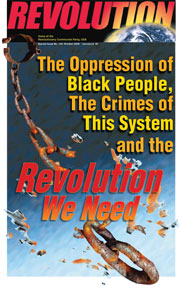Interview with the Artist:
“Inside Ferguson”
July 27, 2015 | Revolution Newspaper | revcom.us
Editors’ note: Bushwick Open Studios is an annual event that draws tens of thousands of people to visit the studios of artists working out of the converted warehouse lofts of the Bushwick district in Brooklyn, New York. An installation that stood out for its message, artistry, and impact was: “Inside Ferguson,” created by photographer Phillip Buehler—an accomplished photographer and writer who, among other projects, is the author of Woody Guthrie’s Wardy Forty: The Interviews. The “Inside Ferguson” installation will be appearing in schools and other venues in the near future. Revolution sat down with Phillip for a conversation about what inspired the project, the experience of going to Ferguson to take the photos for the project, the impact it has had, and his thoughts on the state of the cutting-edge art scene. The following are excerpts from the conversation—the views expressed by Phillip Buehler are, of course, his own.
Photos, courtesy Phillip Buehler
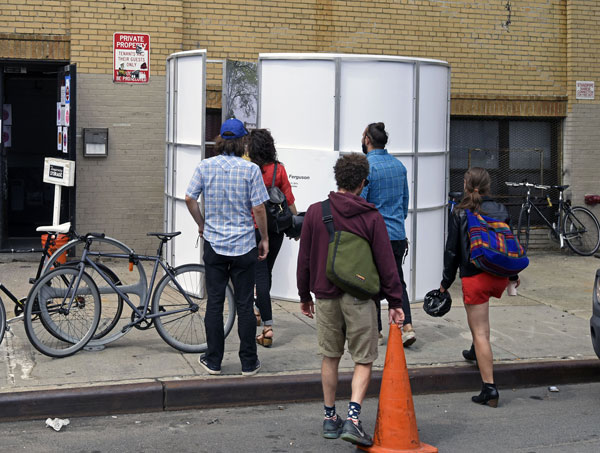
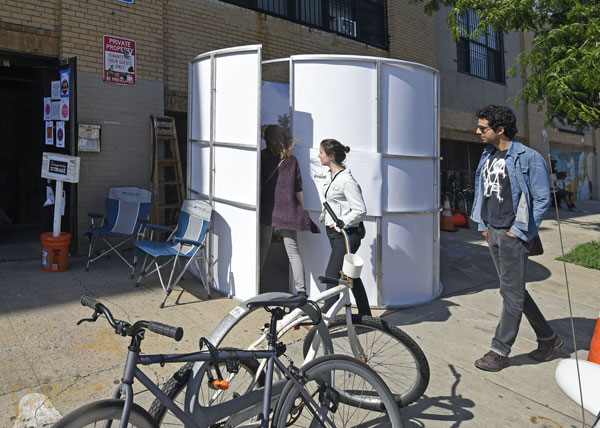
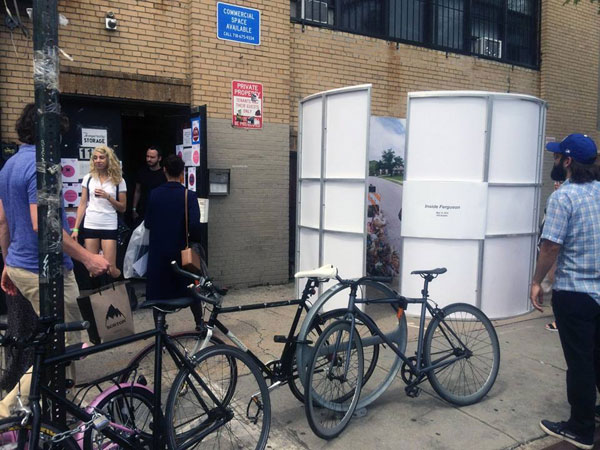
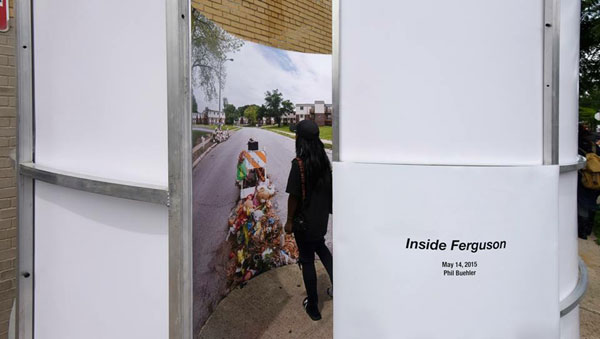
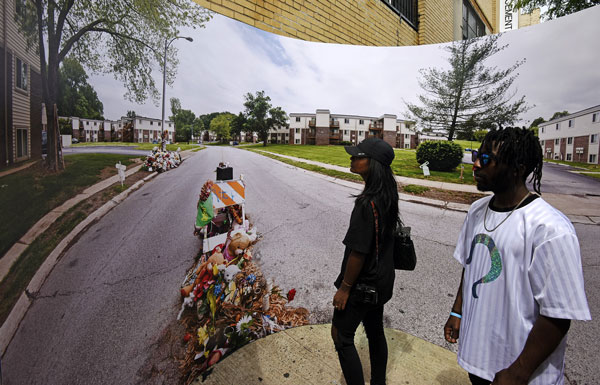
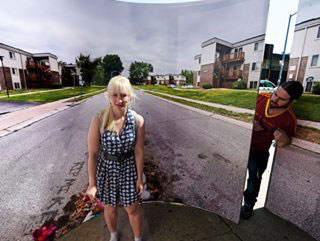
Revolution: You’ve given us permission to use some photos that give some sense of what it is like to experience “Inside Ferguson.” Can you describe that?
Phillip Buehler: The installation’s basically a walk-in photograph in Ferguson. You kind of step into the place, literally. I installed it on a 25-foot-long, eight-foot-tall photograph that’s mounted inside an eight-foot-tall cylindrical frame that wraps around you. It is made from about 40 images. They’re all stitched together.
Revolution: You went to Ferguson and shot those photos. What was that like?
Phillip Buehler: The photos were shot in Ferguson on the street on the location where Michael Brown was killed by a police officer. He fell on the double yellow line in the middle of the street. It’s in a garden apartment community, St. Louis, well-maintained, green lawns. It didn’t seem like a poor neighborhood. It was a lower-income neighborhood, but it was well-maintained. But there on the center line is a stuffed animal memorial, maybe 50 or 60 feet long, stuffed animals, flowers. So I put my camera tripod in the center and photographed that image, 360 degrees, 12 pictures on three different levels.
Revolution: What kind of reaction did you get there as you were doing this?
Phillip Buehler: While I was there. a lot of people came up and asked me what I was doing, African-Americans. A lot of other people were coming and taking pictures of this spot, and pictures of themselves in front of it. You start to realize that it’s like going to the Selma bridge; it’s a landmark in race relations and civil rights in the United States. Everything you saw on television was tear gas and dark and sniper rifles and assault trucks...
Revolution: That really happened!
Phillip Buehler: Yeah, but also, that’s all you saw... It’s almost, I don’t know what. The media is the message, but the media makes the message. You bring the media, and whatever you’re looking for will show up.
Revolution: Are you saying that the humanity of Michael Brown did not come through in the media portrayal?
Phillip Buehler: Not at all. I remember what I was hearing, and it’s through the media filters and your own filters. This guy was shot. “He was coming toward the police.” “He was six-foot-four and weighed 300 pounds.” You get this quite intimidating picture of this guy. “He robbed a store.” And then you realize he’s 19 years old. The cop wasn’t small, the cop was 200 something pounds and six-foot-whatever...
Revolution: And armed with a gun.
Phillip Buehler: Armed with a gun. Then when you get there you see, all you feel, is that this is a kid, and it’s not “Michael Brown,” it’s written in the street, "Mike Brown." It’s Mike. It kind of dehumanizes him by giving his formal name. You realize—maybe he made a mistake, he got so angry. There were people walking in the street when I was there. It’s not an unusual thing in the suburbs to walk in the street. Just to get hassled like that, in that neighborhood, hassling you and giving you a ticket was a way to raise money for the town, for the white powers of the town. You really see: Here’s a poor kid, a kid who’s killed for being Black, essentially, and had a family and people who loved him.
Revolution: Can we talk about what drew you to go to this project?
Phillip Buehler: Ferguson. I didn’t realize when I got there in May that it was one week before the memorial was to be taken down. Actually the impetus to go there was—I did really want to document that, bring it back somehow. I’ve been working on this technique that is immersive in photographs. My work has evolved recently from abandoned places. The book about Woody Guthrie is more about the person than the place. And now I’m... this is a ruin of the person, Michael Brown, kind of about that place, but it’s not the place that’s the ruin, it’s a little bit different evolution of that.
Revolution: Let’s talk a little bit about the installation in Bushwick. This is an area with a massive concentration of alternative artistic activity. You did kind of bring Ferguson into that scene; I’m interested in the reaction.
Phillip Buehler: It’s interesting. This was the industrial part of Bushwick, loft buildings that artists have taken over, kind of gentrification, so we’re kind of surrounded by on one side, projects, on another, industrial wasteland, in another, the Puerto Rican community. It’s all being gentrified eventually, but right now, here, it’s once a year they have Bushwick Open Studios. Six or seven hundred artists open their studios for the weekend; people come and get to see artists in the wild, in their environment, and the work they’re making. From a small scale, it’s becoming really big; tens of thousands of people.
I installed this walking panorama on the street, in front of this studio building—a really interesting thing to do because I’d never installed outdoors. Since it’s an outdoor experience, you actually were getting hit by the sun coming from the top of the panorama and you could feel the wind blowing. It was immersive beyond a gallery. You felt heat if it was a sunny day; you were outdoors.
Revolution: I have to say it’s an intensely visceral experience; you really feel as though you are on the street in Ferguson in a way that no movie or anything else could replicate.
Phillip Buehler: You’re physically there, standing. The artist, making something, it’s like you’re the writer, you can’t read your own book and have the suspense of what happens. I sat on a lawn chair next to it; whoever was interested could come talk to me. Some were real interesting experiences. Some were just enamored with the spectacle of it, the technology, the uniqueness of it, like a walk-in photograph... and technically were interested. It was a fun show event, but that immersed them in it. They would come back out and look at the title, and I would hear people talking, “It’s Ferguson, it’s where they shot that kid!” Then they would go back in and see the stuffed animals, the “Rest in Peace,” and then it became something else. It kind of seduced them into a story they might have walked by. If I knew they were artists and they were above a certain age, it drew them into the politics of it.
In Bushwick now I’d say there’s not much political art; it’s a lot about the Internet and the form and factor, media than it is the message.
Then I installed this around the corner from a shelter for working men.
Revolution: Right. It’s a very large shelter; it serves in part as a halfway house, there’s people released from prison; it’s overwhelmingly Black and Latino guys.
Phillip Buehler: The amazing thing for me is they’d walk by and see “Ferguson” and they’d walk in. These guys released from prison, this was their life too when they were 19 years old. They’d come out and, “I like that!” Not a lot of conversation but an acknowledgment that this was something different. Between the artists who came, the people who were coming to see the art here, and this halfway house; a nice mix, and different reactions. And then some people, you say a visceral reaction—even though it’s a photograph; I didn’t realize it’d be the case, but when you’re in a photograph and it’s four feet away from your eye line, your eyes are trying to focus on that line, but in the image it’s the horizon line. On the one hand your eyes are trying to focus and say that’s four feet away, your brain is going like...
Revolution: It feels like you’re looking down the street in Ferguson.
Phillip Buehler: It’s a little disorienting, especially if you move around off center, because then the lines—in the center of the image they’re all perfect, they all lay out as horizon lines—if you veer off the center it gets a little trippy. I asked people about that; it was unexpected, it changed their experience about Ferguson, now it’s also a disorienting thing. If you had your preconceived notions, now you’re physically disoriented, and open to thinking differently...
Revolution: I will just say as someone who followed Ferguson closely and helped mobilize people to protest, who wrote for Revolution about what an outrage it was, what kind of a system it was part of—even with all that, the installation had a stunning impact on me. People need to be put in the shoes of the Mike Browns of the world, who are marginalized—I’m editorializing here, but oh, well—they’re vilified, they’re pariahs in society. People need to feel what it’s like, to be a large young Black man walking down the street with a target on your back, for whatever reason. I thought what you did was stunningly effective, and I especially appreciated in the context of what you’re saying about Bushwick, where there’s a tremendous amount of innovation, but a lot of it is like what you say, technological or form, without shedding a light on things that need light shed on.
Phillip Buehler: It’s funny... I did want to put a text panel. A lot of art, you talk to the artist and, “...this is the material I use, and it’s my process, and the whole story behind it,” and I just put, “Inside Ferguson.” ...If you didn’t know what Ferguson was, you’re not ready for this.
Revolution: Or you can go find out, now that you’ve been exposed to it.
Phillip Buehler: Or you go in, ...and come out and ask, and that’s what happened. Bring your preconceptions—and then challenge them. You came in and you were like, “Guns and snipers and smoke and guys throwing stuff...” No, that’s not... the humanity is disappeared. I don’t remember any film crews going around the neighborhood asking the local residents what they thought of this thing that was happening.
When I was out there shooting—it’s an interesting tripod rig I have, and I was out there just doing my thing, and a lot of people came. I’ve learned it’s almost like a pilgrimage to go there, it’s like the Selma bridge.
So I was there; people were asking me what I was doing. “You from the news?” I’m like, no, not at all; I’m an artist from Bushwick, Brooklyn, and I wanted to take this back with me. And they were like, “That’s cool!” Because, the news... those people, they’re not showing who we are. There was this anger at being misportrayed.
It’s like the third age of the civil rights movement; the civil war being the first one, the civil rights movement of the ’60s being the second, and this is the third, where it’s like, you know what? It’s not done; we have a Black president, but it’s not done.
Volunteers Needed... for revcom.us and Revolution
If you like this article, subscribe, donate to and sustain Revolution newspaper.







